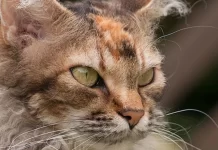Last Updated on August 27, 2023 by Fumipets
Norwegian Forest Cat: Majestic Beauty of the Northern Woods
The Norwegian Forest Cat, known as the “skogkatt” in its homeland, is a magnificent breed that exudes an air of wild elegance. Originating from the forests of Norway, this cat boasts a striking appearance, with its bushy tail, tufted ears, and dense coat adapted to survive harsh Nordic winters. Here’s a summary of the captivating characteristics and intriguing history of the Norwegian Forest Cat.
Norwegian Forest Cat
Norwegian forest cats are big, loving cats that are popularly referred to as “Wegies” by breed enthusiasts. Wegies, also known as skogkatt in their native Norway, are loved there more than anywhere else in the world.
These sweet cats make wonderful companions and are easily recognized by their enormous size and quiet, sensitive demeanor. Norwegian woodland cats are devoted, easygoing pets. The Wegie will make a wonderful family companion if you can give it plenty of affection, careful grooming, and safe surfaces to climb.
Depending on the cat’s age, pedigree, region, and other considerations, the average price of a Norwegian forest cat ranges from $800 to $1,500.
Appearance
Norwegian forest cats have huge, bulky bodies and are active and strong. According to The Cat Fanciers’ Association (CFA), these cats normally weigh between 12 and 16 pounds, with males being larger than females. They also have a long, bushy tail and a thick coat of hair, which gives them the appearance of being even bigger.
Norwegian forest cats are unquestionably larger than the typical domestic cat, which weighs between 8 and 12 pounds, according to Cornell Feline Health Center director Bruce Kornreich, DVM, PhD. They may weigh up to 18 or even 20 pounds.
Their thick, lustrous coats are water-resistant and made to withstand the severe Norwegian winters. Wegies need frequent brushing and maintenance because their undercoat is thick and keeps them warm. In truth, their winter undercoat will molt in the spring. They do lose their coats.
A variety of hues and designs are available for the Norwegian woodland cat coat. White, black, blue, red, cream, silver, and golden are coat colors. The plain, bicolor, tortoiseshell, calico, and tabby hair patterns on this fluffy cat’s coat are all options. They have eyes that are various colours of green, gold, copper, or a combination of all three.
Norwegian forest cats have a more slender build and are somewhat smaller than Wegies, which are sometimes likened to Maine coons in appearance. In contrast to the Maine coon, which has rounder eyes, Norwegian forest cats also have almond-shaped eyes.

Temperament
This breed is often characterized as being kind, tranquil, and gentle. In general, Norwegian forest cats get along well with kids and other animals and may adapt to a variety of households and lifestyles.
These cats like human interaction and affection and are bright and perceptive. Despite their want for attention, they are undemanding and would rather you approach them. Wegies are a calm breed and don’t meow often like, for instance, a Siamese cat, in line with their undemanding character. However, when they do meow, according to Kornreich, their high-pitched cries resemble chirps, which is a comical juxtaposition given their bulky builds.
The Norwegian forest cat has a strong sense of family. They are engaging and affectionate, and they normally accept their environment. This gregarious breed enjoys cuddling and wants to make friends with everyone.
Living Needs
Norwegian forest cat kittens take roughly five years to mature into full adults due to the sluggish maturation of this species. Owners will get to enjoy a lengthier kitten phase of their pet’s life since their maturation is longer than typical (in the world of cats, at least). There will be a lot of play as a result of this kittenish behavior. They particularly like pouncing and honing their hunting techniques—an outdoor-oriented quality that this domesticated breed still retains.
It’s critical, according to Kornreich, to provide your Norwegian forest cat with a way to exercise his keen hunting instincts.
He suggests “toys that mimic mice, and even just something as simple as a cat-approved feather toy and dedicating time every day, five to 10 minutes, to play with them,” he advises. In terms of their hunting behavior, this enables them to hop about, expend energy, and kind of get their rocks off. Additionally, they benefit from the activity.
Norwegian woodland cats are often quite amiable with kids and other animals. These cats are exceptionally patient and well-behaved, so don’t let their size deter you from bringing them into a home with young children. This large breed enjoys socializing with people of all ages and doesn’t get stressed out quickly. Your Norwegian forest cat will probably survive if left alone briefly because of their easygoing, undemanding attitude. However, due to his intense affection for you, separation anxiety may develop if you repeatedly are away for too long.
By nature, Norwegian forest cats are very sociable and usually get along with every member of a family. Wegies really want to get along with everyone, so you may need to keep a closer eye on them to make sure they don’t leave with a crush.
Wegies love to climb and are particularly skilled at doing so.
“All cats like to climb and like to be perched up high, perhaps because of their predatory ancestry,” explains Kornreich. But these cats in particular seem to like climbing a lot.
Every bookshelf, cabinet, and shelf will entice your Norwegian forest cat to investigate the top. To allow your cat to explore securely, construct cat shelves, buy a tall cat tower, and add a cat hammock (or two) to your house. However, be ready to discover your Norwegian woodland cat perched on any surface he can reach and take the necessary safety measures. You must cat-proof fragile vases and trinkets, shaky shelves, and crammed cabinet tops if you don’t want your belongings to fall over.
These cats are heat-sensitive due to the fact that they were developed to resist the severe Norwegian winters. Give your cat plenty of shade, water, air conditioning, and even a shorter haircut while it’s hot outside.
Care
The thick undercoat and lengthy, water-shedding coats of Norwegian forest cats need frequent grooming. At least twice a week should be plenty to brush him; but, during periods of significant shedding (usually in the spring and autumn), you’ll need to brush him even more often.
“Daily combing and brushing is essential if you do not wish to have a close, personal, and frequent relationship with your local groomer,” asserts Nicole Goudey-Rigger, owner and CEO of Pets a Go Go, a supplier of pet care and grooming in New York and Connecticut. Norwegian forest cats are often “lion cut” by customers, particularly indoor cats without access to powerful air conditioning during the summer.
Make sure your Wegie has lots of space to run about and play when it comes to exercise. Although toys, cat trees, and quality playtime with other cats can help keep this athletic cat active, you won’t need to go out of your way to get him moving.
These clever cats are simple to toilet train, but they will need a very big litter box to ensure their comfort.
As with any cats, be sure you clip your Wegie’s nails because if you don’t, he could find making biscuits in the evening a bit too unpleasant. He could respond well to harness training since he is so lively and daring, and he won’t moan if he spends time in a catio outdoors!
As obesity is a danger with this breed, feed your Norwegian forest cat premium cat food and keep an eye on his intake to avoid him from overeating. To find out how much and how often to feed your specific cat, see your veterinarian.
Make sure your Wegie has lots of space to run about and play when it comes to exercise. Although toys, cat trees, and quality playtime with other cats can help keep this athletic cat active, you won’t need to go out of your way to get him moving.

Health
Norwegian forest cats are normally healthy pets with a lifetime of 14 to 16 years. According to Kornreich, the Norwegian forest cat poses the following major health risks:
Hip dysplasia: a disorder where the ball and socket joint in the hip is damaged, which, if ignored, may progress to arthritis.
Patella luxation: a condition in which the knee falls out of place, resulting in a loose and unstable joint.
Cardiomyopathy: a condition where the heart’s microscopic structure is abnormal and affects the heart muscle.
Eosinophilic granuloma complex: a group of skin conditions characterized by red, raised pimples on the skin that may bleed and crust. Although it sometimes occurs on the cat’s face, this is often seen on the inner thigh or lower region of the belly.
Glycogen storage disease type IV: a situation when the breakdown of glycogen into glucose required to power key metabolic functions is unsuccessful. muscular tremors, muscular atrophy, and recurrent bouts of collapsing—usually in kittenhood—are all warning indicators.
Reputable Norwegian forest cat breeders will check your kitten for health problems, but it’s crucial to continue screening them until they are adults.
Schedule regular checkups with the vet and heed his or her instructions to maintain the health of your Norwegian forest cat.
History
Despite having a rather motley look, the Norwegian forest cat is a purebred and not a hybrid. According to the CFA, some specialists even aver that the Norwegian forest cat has existed for generations. These animals undoubtedly suit the description of the huge, long-haired cats mentioned in Norse oral tales that were skilled climbers. It’s difficult to determine precise dates since they are approximated based on oral history, but if the legends are accurate, it’s probable that the Norwegian forest cat has existed for many, many centuries.
The CFA speculates that early Wegies may have traveled with Vikings and were kept as rodent deterrents on their ships. Another hypothesis is that Wegies were initially brought to North America on the ships of early Viking explorers like Leif Erickson, and that the Norwegian forest cat may have been an early predecessor of the Maine coon.
The Norwegian forest cat wasn’t originally considered a breed until the 1930s, but by the 1940s, they were on the verge of extinction. Wegies gained popularity in the 1970s and were legally imported into the U.S. in 1979 after Wegie supporters worked to safeguard the breed.
Q&A: Norwegian Forest Cat
Q1: What makes the Norwegian Forest Cat unique?
The Norwegian Forest Cat stands out for its semi-long coat, tufted ears, and impressive mane-like ruff. These features are well-suited for its ancestral cold climate and contribute to its distinctive and regal appearance.
Q2: What is the history of the Norwegian Forest Cat?
The breed’s origins date back to ancient times, with legends and folklore connecting it to Norse mythology. It’s believed that these cats served as skilled hunters and companions to Vikings, earning their place as cherished members of Norwegian homes.
Q3: What is the personality of the Norwegian Forest Cat?
Norwegian Forest Cats are known for their friendly and outgoing nature. They are intelligent, playful, and form strong bonds with their families. Despite their wild appearance, they have a gentle demeanor and get along well with other pets.
Q4: How do I care for the Norwegian Forest Cat’s coat?
Their thick, water-resistant double coat requires regular grooming to prevent matting and tangles. Brushing a few times a week helps maintain their coat’s health and prevents excessive shedding.
Q5: Is the Norwegian Forest Cat prone to any health issues?
Generally, Norwegian Forest Cats are healthy cats. However, they can be prone to certain genetic conditions such as hip dysplasia and heart conditions. Regular veterinary check-ups and a balanced diet are important for their well-being.
https://www.youtube.com/watch?v=jhS80xObrMI


















